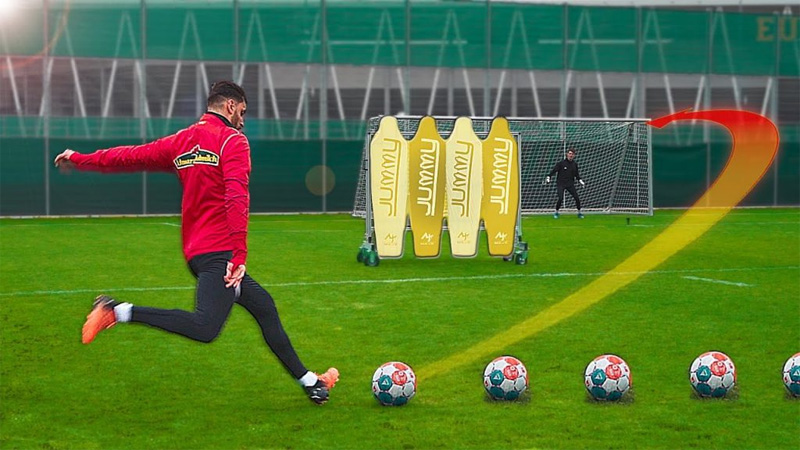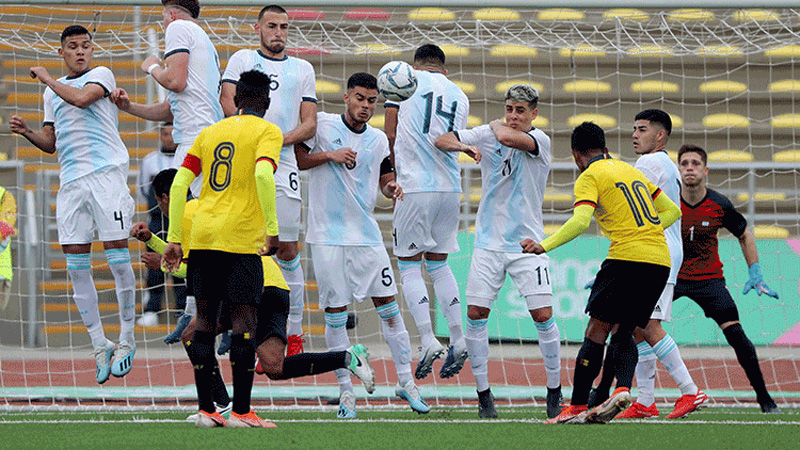What is a set piece in soccer? In the world of soccer, the term “set piece” holds significant importance as it represents a strategic and decisive aspect of the game.
Set pieces refer to planned and rehearsed plays that occur during specific stoppages in the match, such as free kicks, corner kicks, and throw-ins.
These moments provide teams with valuable opportunities to create goal-scoring chances or defend against their opponents effectively.
Set pieces are meticulously crafted through rigorous training sessions, taking into account factors such as player positioning, opponent analysis, and tactical ingenuity.
The successful execution of set pieces requires precision, coordination, and quick thinking on the field.
Whether it’s a free-kick curling into the top corner, a well-timed header from a corner kick, or a defensive wall standing strong to thwart an opponent’s attempt, set pieces often shape the outcome of soccer matches and exemplify the strategic brilliance of the sport.
What Is A Set Piece In Soccer?
In soccer, a set piece refers to any planned and rehearsed play that occurs during certain stoppages in the game, such as free kicks, corner kicks, and throw-ins.
These set pieces provide teams with strategic opportunities to create scoring chances or defend against their opponents effectively.
They are critical moments in a match that can significantly influence the outcome.
Free Kicks
When a foul is committed by a player from the opposing team, the fouled team is awarded a free kick. Depending on the location of the foul, it can be a direct or indirect free kick.
In a direct free kick, the attacking team can shoot directly at the goal, while in an indirect free kick, the ball must touch another player before a goal can be scored. During these moments, teams may devise various set-piece routines to deceive the opposition and create space for a shot on goal.
Corner Kicks
When the defending team is the last to touch the ball before it crosses the goal line but not into the net, the attacking team is awarded a corner kick.
During a corner kick, the ball is placed in the corner arc closest to where it went out of bounds.
The attacking team will then organize a set-piece routine to deliver the ball into the penalty area, aiming to create advantageous scoring opportunities through well-timed runs and precision deliveries.
Throw-ins
When the ball fully crosses the touchline, the opposing team is granted a throw-in from the point where the ball went out of play.
While throw-ins are less common for scoring directly, they can still be used as set pieces to initiate attacking plays or maintain ball possession strategically.
Set pieces are carefully planned by teams during training sessions, taking into account various factors such as the positioning of players, the strengths and weaknesses of the opposing team’s defense, and the element of surprise.
Successful execution of set pieces requires coordination, timing, and creativity, making them an exciting aspect of the game and a testament to the tactical prowess of soccer teams.
What Is The Importance Of Set Pieces In Soccer?

Source: enjogo
Set pieces play a crucial role in soccer and hold significant importance for both attacking and defending teams. Here are some reasons why set pieces are essential in the game:
Goal-Scoring Opportunities:
Set pieces to provide teams with structured chances to score goals. Whether a free kick from a dangerous position or a well-executed corner kick, set pieces offer a focused approach to breach the opponent’s defense. These planned routines enable teams to create space, confuse defenders, and position players strategically, increasing the likelihood of converting chances into goals.
Leveling the Playing Field
Soccer can be an intense and closely contested sport, with matches often decided by narrow margins.
Set pieces offer teams, especially the ones that may be less dominant in open play, an opportunity to compete on a more level playing field.
Even if a team is outperformed during regular play, a well-executed set piece can change the course of a match and lead to a positive outcome.
Strategic Advantage
Set pieces allow teams to capitalize on their opponent’s weaknesses. Coaches and players analyze the opposition’s defensive setup during the game, identifying areas that can be exploited during set pieces.
By tailoring their routines to exploit these vulnerabilities, teams can gain a significant strategic advantage and tilt the momentum of the game in their favor.
Team Cohesion and Communication
Set pieces require precise coordination and communication among players. Strategizing and practicing set-piece routines help teams develop better cohesion on the field.
Players need to understand their roles and responsibilities during set pieces, leading to improved teamwork and a deeper understanding of each other’s playing styles.
Defensive Organization
Set pieces aren’t just about attacking opportunities; they are equally vital for defending teams. Defending set pieces effectively requires disciplined positioning, marking opponents, and staying alert to potential threats.
A well-organized defence during set pieces can prevent conceding goals and maintain a team’s lead or draw in a close game.
Game-Changing Moments
Spectators and fans often get captivated by the dramatic moments that arise from set pieces.
A late goal from a corner kick or a brilliantly executed free kick can completely change the course of a match, creating thrilling and memorable moments that stay etched in soccer history.
Overall, set pieces add an additional layer of excitement, strategy, and unpredictability to soccer matches.
The successful execution of set pieces can determine the outcome of games, making them an integral part of the sport and showcasing the tactical acumen and skill of both players and coaches.
How To Prepare For Set Pieces?

Source: soccercoachweekly
Preparing for set pieces in soccer requires meticulous planning, focused training, and effective communication among players and coaches. Here are some essential steps to prepare for set pieces:
Analyze Opponents and Self-Scouting
Before devising set piece routines, it’s crucial to thoroughly study the strengths, weaknesses, and patterns of the opposing team’s defence and goalkeeper. Identifying areas where the opponent might be vulnerable during set pieces can help tailor specific strategies to exploit these gaps.
Simultaneously, self-scouting is essential to understand your team’s strengths and the players who excel in different roles during set pieces.
Develop Set Piece Routines
Coaches, together with their players, should design set piece routines for various scenarios, such as free kicks from different angles, corner kicks, and throw-ins.
These routines should involve specific player movements, runs, and positioning, ensuring that each player knows their role during the set piece.
Creativity is essential in developing routines that are unpredictable and can catch opponents off guard.
Practice and Repetition
Regular practice of set-piece routines is vital for successful execution during matches. Allocate dedicated training time for set pieces, ensuring that players get sufficient repetition to internalize the movements and timings.
Consistent practice helps build muscle memory and enhances players’ understanding of each other’s roles, leading to better coordination during actual games.
Focus on Timing and Precision
Timing is crucial during set pieces. Players need to be synchronized in their movements, runs, and deliveries to maximize their chances of success.
Emphasize precision in passing and shooting to make the most of goal-scoring opportunities.
Practising dead-ball situations with varying levels of pressure and intensity can help players handle the pressure during actual matches.
Effective Communication
Communication is key to ensuring that set pieces are executed smoothly. Players must be vocal on the field, relaying information about defensive adjustments and positioning.
Clear and concise communication helps avoid confusion and ensures that everyone is on the same page during set pieces.
Adaptability and Flexibility
While having set routines is essential, it’s also crucial to be adaptable during matches. The flow of the game and the opponent’s reactions might require on-the-fly adjustments to set piece plans.
Encourage players to read the game and make quick decisions based on the current situation.
Video Analysis and Feedback
Use video analysis to review and fine-tune set-piece performances. Analyzing both successful and unsuccessful set pieces can provide valuable insights into what works and what needs improvement.
Provide constructive feedback to players, recognizing their efforts and highlighting areas for improvement.
By following these steps, teams can effectively prepare for set pieces, enhancing their chances of converting scoring opportunities and solidifying their defensive resolve during dead-ball situations.
Well-prepared set pieces can be instrumental in determining the outcome of matches and contribute to a team’s overall success in soccer.
Common Set Piece Mistakes
In soccer, set pieces can be game-changing moments, but they can also be opportunities where mistakes can occur.
Here are some common set-piece mistakes that teams and players should be aware of and work to avoid:
Poor Communication
One of the most common set-piece mistakes is a lack of communication among players. Misunderstandings about roles and responsibilities can lead to confusion during set pieces, resulting in missed opportunities or defensive lapses.
Effective communication is essential to ensure that everyone knows their tasks and can coordinate their movements seamlessly.
Predictability
Becoming too predictable in set-piece routines makes it easier for the opposing team to defend against them.
If the opposition can anticipate the movements and actions during set pieces, they can position themselves accordingly and neutralize the threat.
To be effective, teams should incorporate variation and surprise elements into their set-piece strategies.
Poor Timing
Timing is crucial in executing set pieces successfully. Ill-timed runs or poorly delivered passes can disrupt the flow of the play and reduce the chances of scoring.
Players must practice their movements and coordination to ensure they are in the right place at the right time to capitalize on set-piece opportunities.
Lack of Focus
Set pieces often occur during critical moments of the game, and players must maintain focus and concentration.
Lack of focus can result in missed assignments on defense or missed chances on offense. Players must be mentally prepared and fully engaged during set pieces to make the most of these situations.
Overcrowding or Clustering
Overcrowding or clustering of players in a small area during set pieces can lead to chaos and hinder the execution of the play.
Proper spacing and positioning are essential to create space and provide passing options.
Players should avoid bunching up, which can make it easier for the opposition to defend effectively.
Neglecting Defensive Responsibilities
While set pieces often focus on attacking opportunities, players should not neglect their defensive responsibilities.
In the excitement of pushing forward for a goal, players may forget to mark their opponents effectively, leaving gaps in the defense and allowing the opposition to capitalize on counter-attacks.
Lack of Adaptability
Soccer is a dynamic sport, and teams must be adaptable during set pieces. Failing to adjust to the opponent’s defensive setup or reacting to unexpected changes during the play can lead to missed chances or defensive breakdowns.
Overcomplicating Routines
While creativity is essential, overcomplicating set-piece routines can lead to confusion among players and increase the likelihood of errors. Simple and well-rehearsed routines are often more effective than overly complex ones.
Ignoring Second Ball Opportunities
Sometimes, set pieces don’t result in immediate scoring chances, but they can lead to second-ball opportunities. Ignoring these opportunities can prevent a team from maintaining possession or creating additional attacking chances.
By being aware of these common set piece mistakes and addressing them through focused training and effective communication, teams can improve their execution of set pieces and increase their chances of converting these critical moments into goals or defensive successes.
FAQ
What is a set piece in soccer?
In soccer, a set piece refers to any planned and rehearsed play that occurs during specific stoppages in the game, such as free kicks, corner kicks, and throw-ins. These moments provide teams with strategic opportunities to create goal-scoring chances or defend against their opponents effectively.
How are set pieces different from regular plays in soccer?
Set pieces are distinct from regular plays because they occur during specific stoppages caused by fouls, the ball going out of bounds, or other game interruptions.
Unlike continuous open play, set pieces involve a temporary pause in the game, allowing teams to strategize and execute planned routines for offensive or defensive purposes.
Why are set pieces important in soccer?
Set pieces are important in soccer because they offer structured opportunities for teams to score goals or prevent their opponents from doing so.
They showcase a team’s tactical prowess, coordination, and ability to adapt to various game situations.
How do teams prepare for set pieces?
Teams prepare for set pieces through meticulous planning and practice. Coaches analyze opponents’ strengths and weaknesses, designing specific routines to exploit vulnerabilities.
Are set pieces always offensive in nature?
No, set pieces can be both offensive and defensive in nature. While attacking set pieces aim to create goal-scoring opportunities, defensive set pieces focus on organized positioning and marking to prevent the opposing team from scoring.
Conclusion
In the captivating world of soccer, set pieces stand as critical junctures that can sway the tide of a match with their potential to create moments of brilliance or defensive resilience.
From the careful planning and creative intricacies in attack to the disciplined coordination in defense, set pieces embody the essence of tactical thinking and strategic execution in soccer.
These planned plays, be it a free kick, corner kick, or throw-in, require players to work cohesively, communicate effectively, and remain focused amidst the intensity of the game.
The success or failure of set pieces can significantly impact the final result, elevating the importance of mastering these intricate maneuvers on the pitch.
As fans cheer for their favorite teams, set pieces add an extra layer of excitement and unpredictability, making them an integral and captivating part of the beautiful game.







